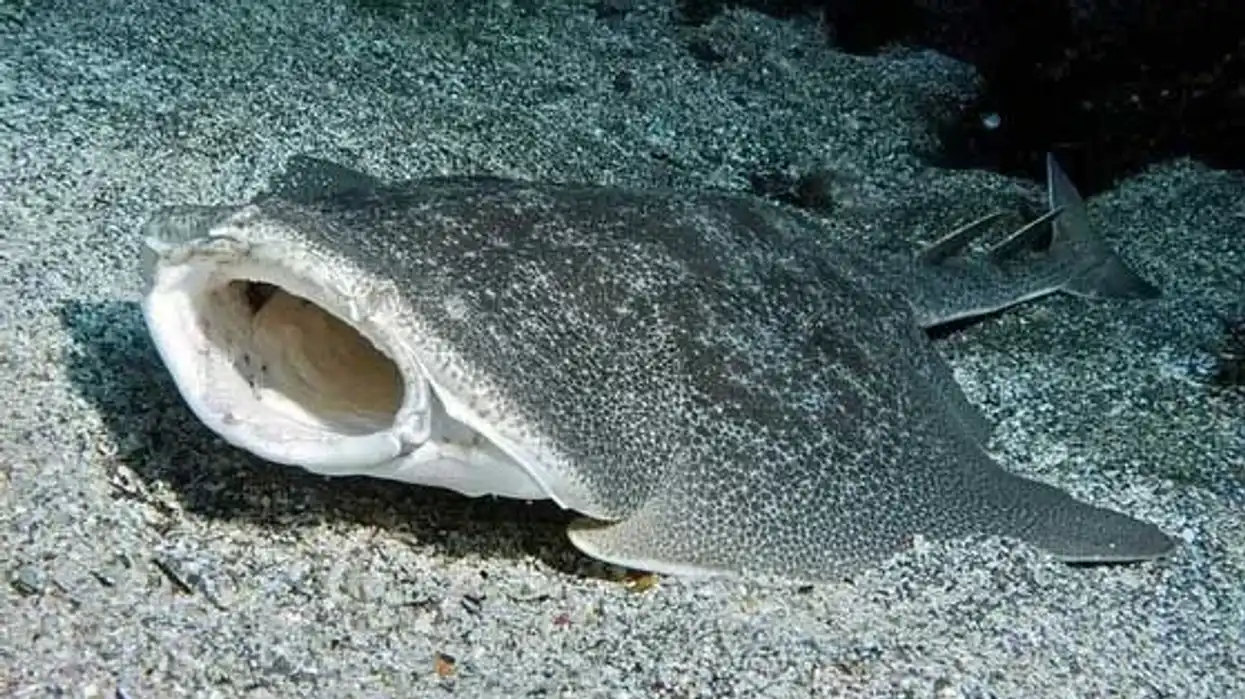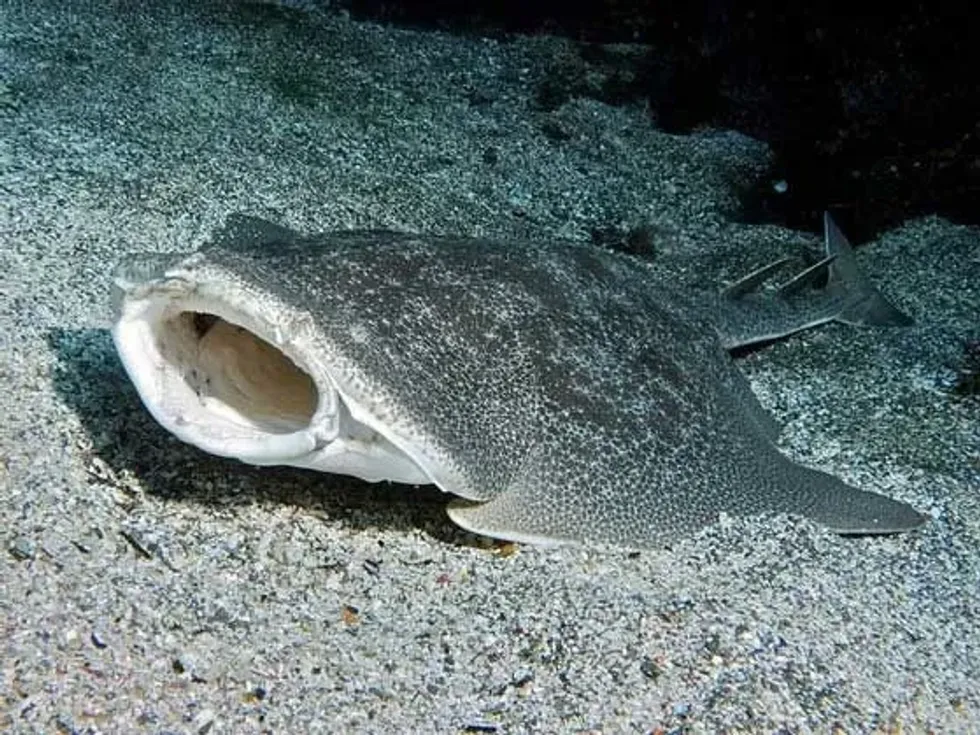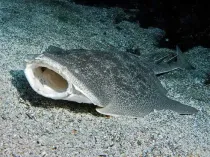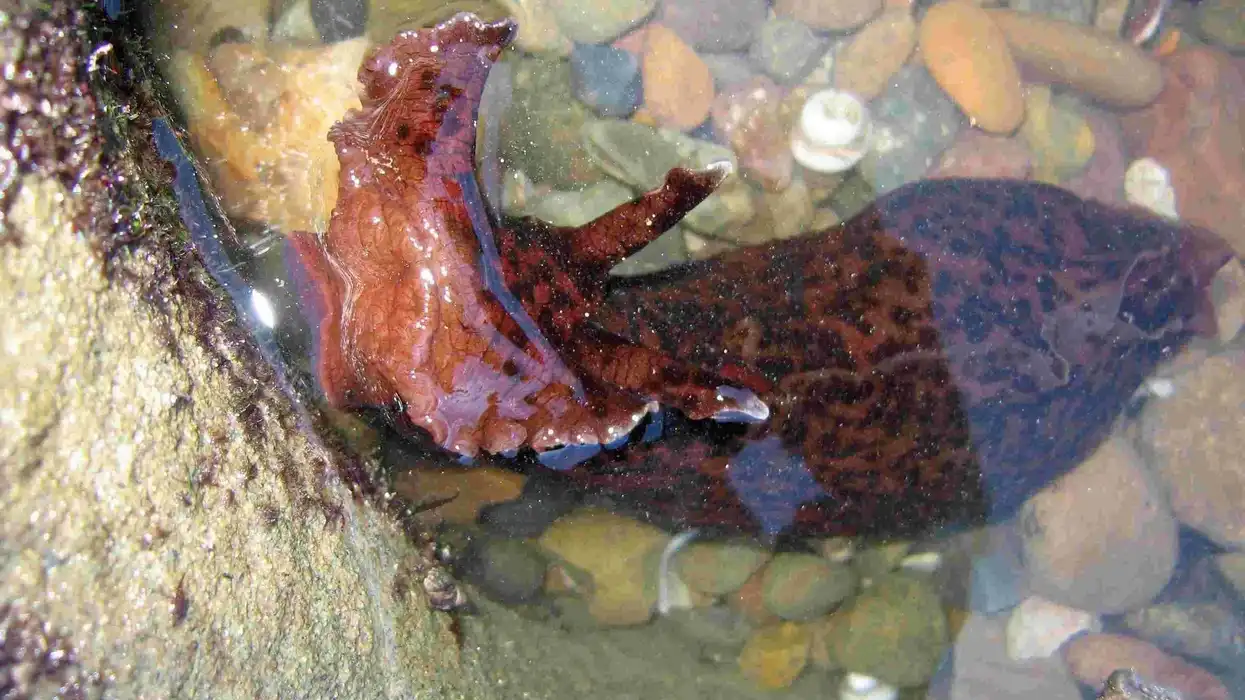Fun Pacific Angelshark Facts For Kids

The angelshark is one of the smaller sharks, with wing-like pelvic and pectoral fins much like the rays which are why they are also called shark rays. They are not known for being particularly aggressive with humans unless provokes.
They mostly eat squids, octopuses, and bony fish and are known for being ambush predators rather than actively seeking food. They have about 9-9 on the upper jaw and about 10-10 on the lower and they are sharp and conical looking.
These fish are critically endangered due to them being hunted quite heavily in the '80s because of their meat, but thankfully that has been restricted to quite an extent in recent years. As they are relatively small they also tend to fall prey to larger species of sharks.
Want to know more interesting facts about these creatures? we suggest you keep reading on.
If you like reading fun facts about sharks, check out Atlantic angelshark facts and sawback angelshark facts.
Pacific Angelshark Interesting Facts
What type of animal is a Pacific angelshark?
As evident by their names, Pacific angelsharks are a type of angelshark. Squatina californica is their scientific name. They are quite similar in appearance to the other species of angel sharks with their flat bodies, wide pelvic and pectoral fins, and gray or brown coloring with dark markings peppered through.
What class of animal does a Pacific angelshark belong to?
These beautiful creatures are members of the shark family that is native to the Eastern Pacific ocean. There is little sexual dimorphism noticed in this species, but the females tend to be larger than the males.
Unfortunately, due to many reasons, their numbers are in a constant decline. However, since they are declared a species facing the threat of extinction, some conservation groups have been working hard to stabilize their numbers.
How many Pacific angelsharks are there in the world?
It is hard to say just how many Pacific angelsharks there are in the world, but their numbers are decreasing. As they are relatively smaller than some of the larger sharks, they tend to fall prey to them.
Humans also used to pose a threat to them due to heavy fishing, but thankfully, they have been controlled to a great extent.
Where does a Pacific angelshark live?
These sharks are found throughout the Eastern Pacific Ocean between Alaska and the Gulf of California and between Ecuador and Chile. Pacific angelsharks used to be hunted heavily in the '80s which contributed to their Near Threatened status on the IUCN red list of endangered animals. However, reports of them being hunted outside of Santa Barbara are extremely rare.
What is a Pacific angelshark's habitat?
Pacific angelsharks are often found in the tropical marine atmosphere along rocky reefs, sand channels, and outcrops. They are bottom dwellers who prefer to stay within shallow waters in moderate depths, but they have been known to go deep under as well.
During the daylight hours, they bury half of themselves in the sand waiting for their favored prey to cross their paths unknowingly, while during the night they take more of an active approach and cruise along the shallow depths of water looking for prey.
Who do Pacific angelsharks live with?
Pacific angelsharks are mostly solitary creatures with the exception of a few who have been known to live in groups. They are semi-migratory the measure of which, again, varies from individual to individual.
While some have been noticed to stay within a single territory for years, others have been noticed to migrate seasonally. During the period of them inhabiting a particular territory, though, they rarely stray far from there.
How long does a Pacific angelshark live?
These angelsharks are known to live a long life, with the highest recorded age of one shark being as much as 35 years. However, as they are one of the relatively smaller shark species, they tend to fall prey to larger sharks, such as the white shark.
How do they reproduce?
These angelsharks are thought to mate annually and are known to give birth throughout March to June.
About 1-13 eggs are produced which get hatched inside the mother's body. These eggs do not have any external source of nutrition, rather an external yolk provides all the nutrition needed and it shrinks as the embryo grows and then reaches an internal sac where the stored yolk gets transferred to the embryo's intestine and then promptly digested.
Another interesting fact is that even though the litter size can range anywhere up to 13, the usual number of pups is between 8-13.
What is their conservation status?
Pacific angelsharks are currently enlisted in the IUCN red list of endangered animals as a Near-Threatened species due to many reasons.
One of the major ones could be attributed to their relatively smaller size in comparison to other larger shark species. Many larger sharks like white sharks are known to prey on them.
They were also heavily hunted during the '80s, but thankfully due to their near-threatened status, many conservation groups came forward and eventually put a rest to the heavy fishing of this species, and are working hard to stabilize their population.
Pacific Angelshark Fun Facts
What do Pacific angelsharks look like?
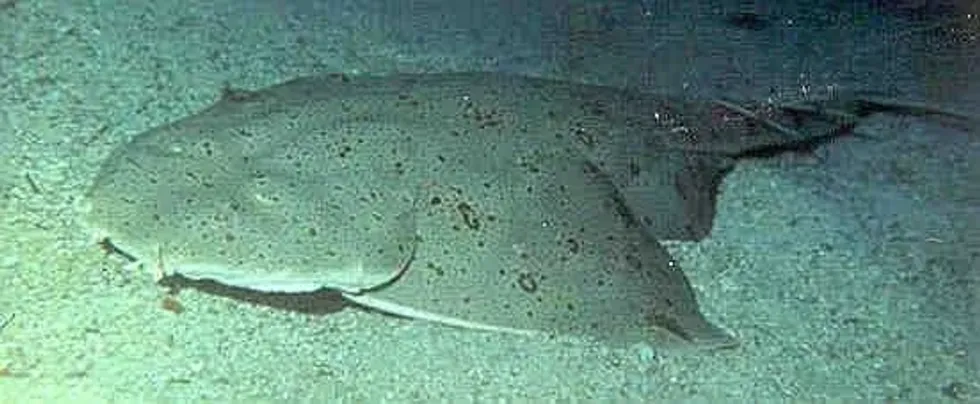
These angelsharks have large flattened bodies with wing-like pelvic and pectoral fins. The pectoral fins are larger than the pelvic fins, but still quite similar in shape.
Other names of these angelsharks, rays, and chimeras of California are due to their similar body shape to that of the rays. They have gill slits located from under their throat to the side of their large head.
A wide mouth with sharp teeth is situated at the edge of their snout which helps them to ambush their prey easily. They have 18 teeth in the upper jaw and 20 in the lower jaw.
Their eyes are strangely located on top of the head as well as their fleshy nasal lobes and flaps. These angelsharks have two dorsal fins that are spineless and a well-developed caudal fin.
Unlike most other species of sharks, the caudal fin of these sharks is quite different with their upper lobe shorter than the lower ones. These angel sharks are usually white in color with gray, brown, or red spots peppered through.
However, individuals with a dark brown coloring have been found. This coloration is thought to help them stay hidden in the marine substrate where they lie awaiting their prey to cross their path unknowingly.
How cute are they?
They are quite cute with their whitish color with dark spots peppered through them. These sharks have a flat body with wing-like pelvic and pectoral fins, these wing-like pectoral fins are why they are also called shark rays.
They are found throughout the Eastern Pacific ocean, namely in between Alaska and the Gulf of California, and between Ecuador and Chile, but experts think that they could very well be two different species of Pacific angelshark. Squatina californica is their scientific name.
How do they communicate?
These angelsharks are electroreceptive, which means that they rely on the perception of electric fields while hunting for food.
They are also known to use their visual senses for the same.
Another interesting fact about these angelsharks is that while it is necessary for other shark species to cruise or swim in order to breathe, these sharks have evolved to pump water out of the gills and spiracles which enables them to stay hidden in the marine substrate without moving at all.
This also helps them to suddenly push upwards from where they lie hidden in the sand or mud to ambush their unsuspecting prey.
How big is a Pacific angelshark?
Pacific angelsharks are relatively smaller than most other shark species and their range length is about 48-60 in (122-153 cm), which is about the same size as a black vulture. How cool is that!
How fast can a Pacific angelshark swim?
While it is hard to measure their exact swimming speed, it is assumed that they do not swim very fast as these fish are ambush predators. Pacific angelshark prefers to stay hidden in the marine substrate where it lies in wait for its primary food sources that are squids, octopuses, and bony fish.
How much does a Pacific angelshark weigh?
These sharks are actually one of the smaller species of sharks and are prone to fall prey to larger species. They only weigh about 60-77 lb (27.2-35 kg).
What are the male and female names of the species?
Sharks do not have sex-specific names for their male and female counterparts, and these fish are no different. The male is just called a male Pacific angelshark and the female is just called a female Pacific angelshark. Squatina californica is their scientific name.
What would you call a baby Pacific angelshark?
Like all other shark species, the babies of these angelsharks are called pups and they are about 9 in (24cm) long at birth.
What do they eat?
These angelsharks are known to be carnivores who feed primarily on squids, octopuses. They also eat bony fish like croakers, sea basses, blacksmiths, Cortina, flatfish, tunas, bonitos, and mackerel.
They also eat peppered sharks and Pacific sardines as well as hake and halibut. These sharks are known for their intelligence. They bury themselves in the marine substrate in the sand or mud and stay hidden in wait for their unsuspecting prey.
They then perform mediated strikes and ambush their prey out of the blue. They are also known for going back to places where food sources were heavily distributed periodically.
Are they dangerous?
While the Pacific angelsharks are not known to be particularly dangerous, they have been known to bite if provoked.
As they tend to lie still waiting for their prey in the marine substrate, divers tend to touch them, which is not at all recommended because their self-preservation can kick in and they can end up biting you to defend themselves.
However, their bites are not known to be severe usually.
Would they make a good pet?
Sharks of any kind do not make good pets, and the Pacific angelshark is no different. As they live in the ocean and you can not create an ocean-like environment in your home, it is ill-advised to keep them as pets.
They are also wild creatures and like most other wild creatures have an unpredictable temperament, which means that they can end up injuring you from a misguided sense of self-defense.
Did you know...
These fish do not like to move. In fact, they have evolved to an extent where they can just pump water out of their gill slits so they can stay hidden and breathe without moving at all.
Pacific angelsharks and humans
These beautiful creatures are sometimes hunted by humans for their meat which is considered to be a delicacy. They also make fairly easy prey because of their relatively smaller size and generally calm nature. They are not known to attack humans unless provoked.
Why are angelsharks endangered?
In the '80s, these fish were heavily hunted which is why this species is now critically endangered. They are listed as a Near Threatened species in the IUCN Red List of endangered animals.
Another reason why they are facing the threat of extinction is that they are relatively smaller than most types of sharks, and tend to fall prey to them.
Here at Kidadl, we have carefully created lots of interesting family-friendly animal facts for everyone to discover! Learn more about some other fish including Japanese sawshark facts, or basking shark facts.
You can even occupy yourself at home by coloring in one of our free printable pacific angelshark coloring pages.
We Want Your Photos!
More for You
See All
Bachelor of Arts specializing in Journalism and Mass Communication, Postgraduate Diploma in Sports Management

Moumita DuttaBachelor of Arts specializing in Journalism and Mass Communication, Postgraduate Diploma in Sports Management
A content writer and editor with a passion for sports, Moumita has honed her skills in producing compelling match reports and stories about sporting heroes. She holds a degree in Journalism and Mass Communication from the Indian Institute of Social Welfare and Business Management, Calcutta University, alongside a postgraduate diploma in Sports Management.
Bachelor of Arts specializing in Economics

Gowri RaoBachelor of Arts specializing in Economics
With a bachelor's degree in Economics from Krea University, Gowri is a highly skilled data analyst and an expert in regression and causation modeling. Her interests in economic trends, finance, and investment research complement her professional expertise. In addition to her professional pursuits, Gowri enjoys swimming, running, and playing the drums, and she is also a talented tutor.
Disclaimer
1) Kidadl is independent and to make our service free to you the reader we are supported by advertising. We hope you love our recommendations for products and services! What we suggest is selected independently by the Kidadl team. If you purchase using the Buy Now button we may earn a small commission. This does not influence our choices. Prices are correct and items are available at the time the article was published but we cannot guarantee that on the time of reading. Please note that Kidadl is a participant in the Amazon Services LLC Associates Program, an affiliate advertising program designed to provide a means for sites to earn advertising fees by advertising and linking to Amazon. We also link to other websites, but are not responsible for their content.
2) At Kidadl, we strive to recommend the very best activities and events. We will always aim to give you accurate information at the date of publication - however, information does change, so it’s important you do your own research, double-check and make the decision that is right for your family. We recognise that not all activities and ideas are appropriate for all children and families or in all circumstances. Our recommended activities are based on age but these are a guide. We recommend that these ideas are used as inspiration, that ideas are undertaken with appropriate adult supervision, and that each adult uses their own discretion and knowledge of their children to consider the safety and suitability. Kidadl cannot accept liability for the execution of these ideas, and parental supervision is advised at all times, as safety is paramount. Anyone using the information provided by Kidadl does so at their own risk and we can not accept liability if things go wrong.
3) Because we are an educational resource, we have quotes and facts about a range of historical and modern figures. We do not endorse the actions of or rhetoric of all the people included in these collections, but we think they are important for growing minds to learn about under the guidance of parents or guardians.
